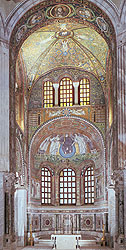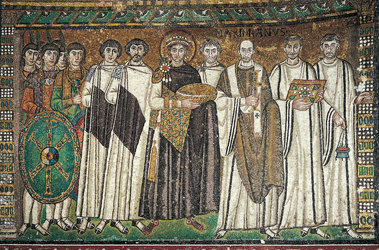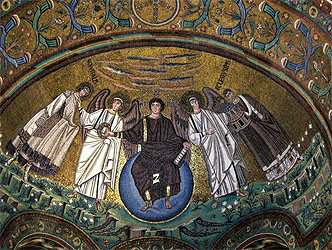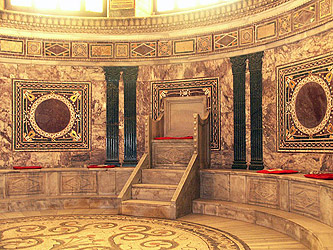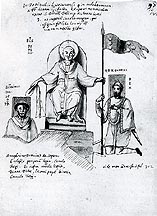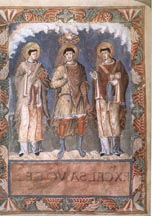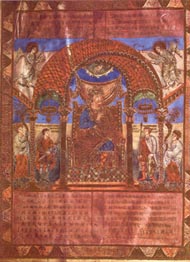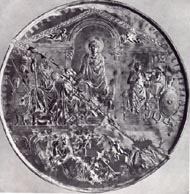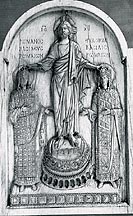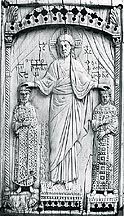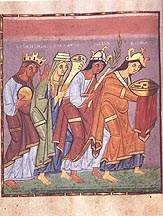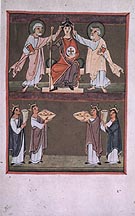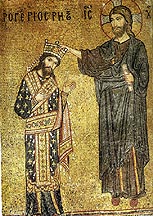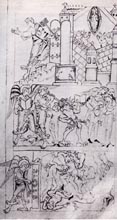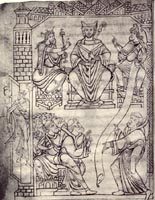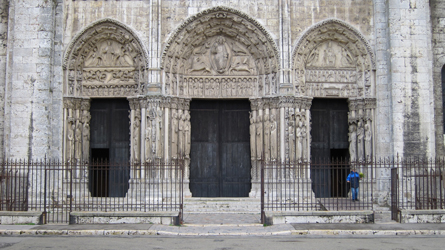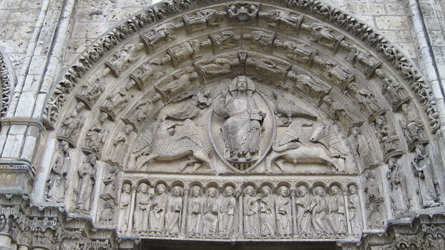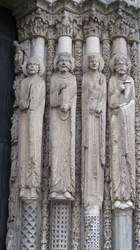ART Home | ARTH Courses | ARTH 200 Assignments
Medieval Images of Power
There is only one who is enthroned in the realm of the air, the thunderer. It is proper that under him, one only be the ruler on earth
The Middle Ages conceived of the Cosmos as an orderly system of the earth as a mirror of heavens. The earthly kingdom is a reflection of the heavenly kingdom. Earthly rulers receive their dominion from God, and it is their responsibility at the end of time to return their dominion to God. History has a plan and destiny ending with the Second Coming and the return of Christ, the True King. Before that time it is the responsibility of earthly rulers to lead the Chosen People or Elect just as Abraham, Moses, David, Solomon, and the other Old Testament leaders lead the Israelites in the Old Testament.
But the earthly kingdom is not a perfect mirror of the heavenly kingdom [I Corinthians, XIII, 12: We see now through a glass in a dark manner; but then face to face. Now I know in part; but then I shall know even as I am known.]. The Fall of Man has made the earthly kingdom an imperfect reflection of heaven. This awareness of the Fall had a profound effect on how people in the Middle Ages looked at the world and themselves. The Christian message was to deny this physical world and to attempt to attain the spiritual world. Humans due to their fallen nature cannot attain this alone but need the mediation of Christ to achieve salvation. Consider the implications this ideology has had on western civilization. For the Middle Ages it created a series of interconnected dichotomies: heaven/hell; sacred/profane; spiritual/ physical; good/evil; truth/falsehood; elect/damned; soul/body; etc. For the Medieval person there was a profound sense of alienation. The individual was understood as a "homo viator" or wanderer in this world in constant pursuit of the true home. This ideology is still influential today. It still influences the way we look at the physical world. It has had at times devastating impact on how we look at the political world. It even effects the way we look at ourselves. There is no Truth with a capital "T" to seeing the world this way. It is based on belief. In your journal, I would like you to consider the ways you see this world-view still at work. Watch out for falling into the trap of saying that is an ideology that others have but you are outside of it. None of us can possibly be outside of it.
Returning to the Middle Ages, the beliefs that earth mirrors heaven and that humanity is essentially in a Fallen state are central to political thought. Since the power of the ruler was understood to come from God and also considering the Fallen nature of humanity, it was the reponsibility of all good Christians to be obedient to the authority of their rulers. An act against the earthly representative of divine authority was understood as an act against God. [As something to consider, I wonder how much our modern ideas of patriotism were formed in this medieval political ideology. It is not a coincidence that Evangelical Christians are strongly patriotic.]
One of the most famous images of political authority from the Middle Ages is the mosaic of the Emperor Justinian and his court in the sanctuary of the church of San Vitale in Ravenna. This image is an integral part of a much larger mosaic program in the chancel. A major theme of this mosaic program is the authority of the emperor in the Christian plan of history. The mosaic program can also be seen to give visual testament to the two major ambitions of Justinian's reign: as heir to the tradition of Roman Emperors, Justinian sought to restore the territorial boundaries of the Empire. As the Christian Emperor, he saw himself as the defender of the faith. As such it was his duty to establish religious uniformity or Orthodoxy throughout the Empire.
In the chancel mosaic Justinian is posed frontally in the center. He is haloed and wears a crown and a purple imperial robe. He is flanked by members of the clergy on his left with the most prominent figure the Bishop Maximianus of Ravenna being labelled with an inscription. To Justinian's right appear members of the imperial administration identified by the purple stripe, and at the very far left side of the mosaic appears a group of soldiers. This mosaic thus establishes the central position of the Emperor between the power of the church and the power of the imperial administration and military. Like the Roman Emperors of the past, Justinian has religious, administrative, and military authority. The clergy and Justinian carry in sequence from right to left a censer, the gospel book, the cross, and the bowl for the bread of the Eucharist. This identifies the mosaic as the so-called Little Entrance which marks the beginning of the Byzantine liturgy of the Eucharist. Justinian's gesture of carrying the bowl with the bread of the Eucharist can be seen as an act of homage to the True King who appears in the adjacent apse mosaic. Christ, dressed in imperial purple and seated on an orb signifying universal dominion, offers the crown of martyrdom to St. Vitale, but the same gesture can be seen as offering the crown to Justinian in the mosaic below. Justinian is thus Christ's vice-regent on earth, and his army is actually the army of Christ as signified by the Chi-Rho on the shield.
Closer examination of the Justinian mosaic reveals an ambiguity in the positioning of the figures of Justinian and the Bishop Maximianus. Overlapping suggests that Justinian is the closest figure to the viewer, but when the positioning of the figures on the picture plane is considered, it is evident that Maximianus's feet are lower on the picture plane which suggests that he is closer to the viewer. This can perhaps be seen as an indication of the tension between the authority of the Emperor and the church. In a letter written by Pope Gelasius I to the Emperor Anastasius in 494, the Pope clearly states his claim of supremacy:
| There are two powers, august Emperor, by which this world is chiefly ruled, namely, the sacred authority of the priests and the royal power. Of these that of the priests is the more weighty, since they have to render an account for even the kings of men in the divine judgment. You are also aware, dear son, that while you are permitted honorably to rule over human kind, yet in things divine you bow your head humbly before the leaders of the clergy and await from their hands the means of your salvation. In the reception and proper disposition of the heavenly mysteries you recognize that you should be subordinate rather than superior to the religious order, and that in these matters you depend on their judgment rather than wish to force them to follow your will. |
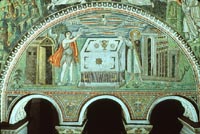 Other
figures in the mosaic program suggest the place of Justinian in the Christian
plan of history. For example, the figure of Melchisedech as the priest-king
of Salem is a clear parallel to Justinian who can be understood as a priest-king
over Jerusalem, the new Salem. The mosaic showing Melchisedech along with
Abel making offerings makes explicit the typological meaning of Melchisedech's
offering to Abraham of bread and wine as a prefiguration of the Christian
Eucharist. At the same time the figures of Abraham
the first patriarch and Moses who led the Israelites to the Promised Land
are Old Testament precursors of Justinian as leaders of the Chosen People.
Other
figures in the mosaic program suggest the place of Justinian in the Christian
plan of history. For example, the figure of Melchisedech as the priest-king
of Salem is a clear parallel to Justinian who can be understood as a priest-king
over Jerusalem, the new Salem. The mosaic showing Melchisedech along with
Abel making offerings makes explicit the typological meaning of Melchisedech's
offering to Abraham of bread and wine as a prefiguration of the Christian
Eucharist. At the same time the figures of Abraham
the first patriarch and Moses who led the Israelites to the Promised Land
are Old Testament precursors of Justinian as leaders of the Chosen People.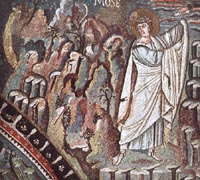 Both the mosaic of Moses being called to lead he Israelites in the scene of
Moses and the Burning Bush and the mosaic of Moses receiving the Ten Commandments
would have resonated for Justinian. Like Moses, Justinian understood himself
to be divinely chosen and also like Moses he saw himself as the law-giver.
In 529 Justinian issued the Corpus Juris Civilis. Out of a desire for
order and uniformity which mirrored his concerns for religious orthodoxy,
Justinian directed his advisers to reorganize and revise the whole body of
Roman law in one official compilation, eliminating contradictions and obsolete
laws and reducing the bulk to manageable proportions. The legal systems of
all the modern national states of Western Europe are either based upon, or
were influenced by Justinian's codification of Roman law.
Both the mosaic of Moses being called to lead he Israelites in the scene of
Moses and the Burning Bush and the mosaic of Moses receiving the Ten Commandments
would have resonated for Justinian. Like Moses, Justinian understood himself
to be divinely chosen and also like Moses he saw himself as the law-giver.
In 529 Justinian issued the Corpus Juris Civilis. Out of a desire for
order and uniformity which mirrored his concerns for religious orthodoxy,
Justinian directed his advisers to reorganize and revise the whole body of
Roman law in one official compilation, eliminating contradictions and obsolete
laws and reducing the bulk to manageable proportions. The legal systems of
all the modern national states of Western Europe are either based upon, or
were influenced by Justinian's codification of Roman law.
The image
above is an 18th century watercolor copy of a now lost mosaic that was in
the Hall of Leo III in the Lateran Palace in Rome. This mosaic in the palace
of the Popes lays out the central concept of political authority for the western
Middle Ages. At the center of the image appears the figure of St. Peter whose
frontal pose clearly recalls images of Christ. To his right appears the figure
of Pope Leo III while to his left is the kneeling figure of Charlemagne.  The
image is based on the Roman formula of the traditio legis or the
Emperor as the lawgiver as exemplified by the late fourth century silver plate
known as the Missorium of Theodosius.
The
image is based on the Roman formula of the traditio legis or the
Emperor as the lawgiver as exemplified by the late fourth century silver plate
known as the Missorium of Theodosius.  The
traditio legis formula was adapted by Early Christian artists with
representations of Christ handing down authority to Sts. Peter and Paul as
exemplified by the central group from the Junius Bassus Sarcophagus from c.
359. The Lateran mosaic articulates the division of power in the Middle Ages
between the sacerdotium or the priesthood and the regnum or
kingship. Both church and state receive their authority from St. Peter. The
papacy is understood to be the lineage of Peter. In the church's role as the
earthly representative of the authority of Peter, Medieval kings were crowned
by Bishops, as dramatically exemplified by the coronation of Charlemagne as
Emperor by Pope Leo III in the church of Old St. Peter's on Christmas day,
800. This Lateran mosaic thus makes clear the authority of the Roman Church
lead by the Pope in granting political authority. This image echoes the famous
Donation of
Constantine a forgery of the second half of the eighth century probably
drafted by Pope Stephen II to establish Papal claims to authority.
The
traditio legis formula was adapted by Early Christian artists with
representations of Christ handing down authority to Sts. Peter and Paul as
exemplified by the central group from the Junius Bassus Sarcophagus from c.
359. The Lateran mosaic articulates the division of power in the Middle Ages
between the sacerdotium or the priesthood and the regnum or
kingship. Both church and state receive their authority from St. Peter. The
papacy is understood to be the lineage of Peter. In the church's role as the
earthly representative of the authority of Peter, Medieval kings were crowned
by Bishops, as dramatically exemplified by the coronation of Charlemagne as
Emperor by Pope Leo III in the church of Old St. Peter's on Christmas day,
800. This Lateran mosaic thus makes clear the authority of the Roman Church
lead by the Pope in granting political authority. This image echoes the famous
Donation of
Constantine a forgery of the second half of the eighth century probably
drafted by Pope Stephen II to establish Papal claims to authority.
The page above comes from the so-called Metz Sacramentary made at the Court School of the Carolingian king Charles the Bald about 870. The miniature shows a Carolingian ruler flanked by two bishops and crowned by the hand of God from above. The image illustrates the divine source of authority and the role of the church in acclaiming the coronation.
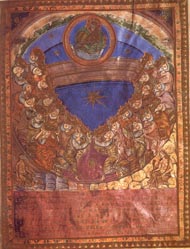 |
The images are facing pages from a manuscript known as the Codex Aureus of St. Emmeram, or the Golden Book of St. Emmeram. Written for the Carolingian King Charles the Bald about 870, the manuscript contains the four Gospels. The left or verso page shows Charles the Bald enthroned in the center. The text below written in gold letters identifies the king and links him with Old Testament kings like David and Solomon. Reaching from the canopy above is the hand of God signifying divine sanction of Charles' power. The canopy provides not just a formal setting and division of the image, but it also signifies the idea of the dome of heaven. Charles is immediately flanked on either side by the smaller figures of soldiers who are in turn flanked by crowned female figures holding cornuacopias. Inscriptions label these figures as personifications of Francia and Gotia. The figure of Charles the Bald looks to his left and above thus linking him with the facing page which shows the Adoration of the Lamb. Based on the Book of Revelation (chapters 4-8), the Adoration of the Lamb shows the appearance of Christ in the form of Lamb at the end of time. Below are personifications of Sea and Earth. Encircling the lamb, the Twenty-Four Elders rise from their seats and offer their crowns to the Lamb. This signifies the idea of earthly kings returning their crowns or power to Christ, the True King, at the end of time. The imagery of these facing pages clearly echoes the symbolism and lay-out of the Palace Chapel of the Carolingian Kings in their capital of Aachen or Aix-la-Chapelle.
The conventions for Imperial representation shown in the image of Charles the Bald can be clearly connected by to Late Antique imagery. A particularly striking comparison can be made back to the so-called Missorium of Theodosius, a silver plate made in 388 to mark the tenth anniversary of the Emperor's accession to Imperial power. The strong similarities of these images clearly support the central idea of Carolingian political theory of the Renovatio imperii Romani, or Renovation of Imperial Rome.
The second half of the tenth century witnesses the revival of the idea of the Empire in the west with the creation of the Ottonian dynasty. A tension throughout the Middle Ages was between the central authority of a monarch and the particularism of the power of local lords. While particularism dominated in France from the tenth to the beginning of the twelfth century, the German kings under the Ottonian Dynasty were able to assert the power of strong monarchy. This claim of a strong royal power was given visual form by Ottonian artists.
Otto II who married the daughter of a Byzantine Emperor was heavily influenced by the Byzantine Empire. This is clearly documented by this comparison of a Byzantine ivory and an Ottonian ivory showing Otto II and Theophanou. These ivories give visual testament to the divine source of imperial power with the figure of Christ in the center of both ivories crowning the emperor and empress.
The image
above comes from the so-called Aachen Gospels made for Otto III about the
year 996. Otto III was the heir to the Ottonian dynasty. The Ottonians were
heirs to the Carolingians. In the tenth century the Ottonians revived the
disintegrated Holy Roman Empire. The dominion of the Ottonians was not as
extensive as the Carolingians. Their territories included Germany and northern
Italy. Like the image from the Codex Aureus, this image is based on the Book
of Revelation. The central figure here is Otto who is in the guise of Christ.
In a detail not shown in the Codex Aureus image, the Revelation passage describes
that the Lamb appeared surrounded by Four Beasts. 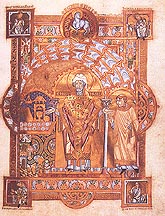 These
Beasts became symbolically connected to the Four Evangelists: Winged Man=Matthew;
Winged Lion=Mark; Winged Ox=Luke; and Eagle=John. These beasts flank Otto
and hold onto a scroll that signifies the Gospels. This scroll is symbolically
connected to the Book of Seven Seals that the Lamb will open at the end of
time. The mandorla and the open armed gesture further link the figure of Otto
III with Christ. This open armed gesture is the same as that a priest makes
in the celebration of the Mass.The gesture can be understood to reflect Christ
on the Cross.
These
Beasts became symbolically connected to the Four Evangelists: Winged Man=Matthew;
Winged Lion=Mark; Winged Ox=Luke; and Eagle=John. These beasts flank Otto
and hold onto a scroll that signifies the Gospels. This scroll is symbolically
connected to the Book of Seven Seals that the Lamb will open at the end of
time. The mandorla and the open armed gesture further link the figure of Otto
III with Christ. This open armed gesture is the same as that a priest makes
in the celebration of the Mass.The gesture can be understood to reflect Christ
on the Cross.
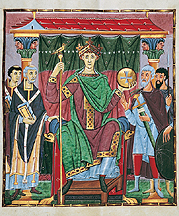 |
These are facing pages from another Gospel Book made for Otto III about 1000. They show the Emperor enthroned before a magnificent cloth of honor. His throne with lions' heads and feet can be traced back to the sella curulis the traditional seat of the magistrate in ancient Rome. It would continue to be a throne in later French history. He is flanked by representatives of the clergy on the left and lay figures holding swords on the right. The layout of the image is clearly based on the tradition of imperial images that go back to Antiquity. Like the Missorium of Theodosius discussed earlier, Otto III is placed frontally in the center of the image. Through the use of hierarchic scaling the flanking figures are clearly subordinated to Otto. We see the figures on either side of Otto as representing the major division in Medieval society between regnum and sacerdotium or the secular authority of the state and the religious authority of the church. The figure of Otto III is approached on the facing page by four personifications signifying the different lands of "Sclavinia, Germania, Gallia, Roma." The homage shown by the crowned personfications offering gifts to the enthroned Otto III visually echoes the imagery of the Adoration of the Magi. The act of homage shown here reflects the importance of homage in the political life of this period. Alliances were not institutional as much as personal. In feudal society it was critical that a vassal demonstrated his loyalty to his lord through the act of homage.
![]() An
image like this challenges our assumptions about the nature of portraiture.
Our expectation is that the portrait should distinguish the particular likeness
of the individual represented. But in the portrait of Otto III, his frontal
position and large eyed stare bears a striking resemblance to the portraits
of Constantine the Great and other imperial representations from the fourth
century. Instead of focusing on individual likeness, the artist has devoted
great attention to the delineation of the symbols of Otto III's power: Otto's
purple tunic, orb, scepter topped with an eagle, cloth of honor, the lion
heads on the imperial throne, and the huge gemmed crown are clear symbols
of Imperial power. The physiogomy of the first bishop is clearly based on
the St. Peter type.
An
image like this challenges our assumptions about the nature of portraiture.
Our expectation is that the portrait should distinguish the particular likeness
of the individual represented. But in the portrait of Otto III, his frontal
position and large eyed stare bears a striking resemblance to the portraits
of Constantine the Great and other imperial representations from the fourth
century. Instead of focusing on individual likeness, the artist has devoted
great attention to the delineation of the symbols of Otto III's power: Otto's
purple tunic, orb, scepter topped with an eagle, cloth of honor, the lion
heads on the imperial throne, and the huge gemmed crown are clear symbols
of Imperial power. The physiogomy of the first bishop is clearly based on
the St. Peter type.
As noted above, the relationship between the authority of the Emperor and the authority of the Church was a central issue in the Middle Ages. Otto III in these images makes clear his theocratic notion of kingship. He places the church represented by a bishop in the likeness of St. Peter in a clearly subordinate position to himself. Otto entitled himself "servant of Jesus Christ," "servant of the Apostles". in competition with the formulation of the Papacy as the servus servorum Dei [servant of the servants of God]. Otto III considered the Pope as one of his optimates, and treated Rome as his capital. Otto questioned the authenticity of the Donation of Constantine that had become a foundation for Papal authority. Otto III in these images fashions himself as a new Constantine.
The miniature above is another representation of Otto III. It comes from the so-called Bamberg Apocalypse. It is clearly related to the imagery of the frontispiece from his Gospel Books discussed above. The appearance of this image in a manuscript of the Apocalypse reminds us of the millenial concerns that Europe experienced around the year 1000. The role of the Emperor in this Christian plan of history is also made manifest.
In 1130, Roger II became the first Norman king of Sicily. He established a cosmopolitan court that witnessed a rich mixture of traditions including the Latin West, the Byzantine East, and Islamic culture. He devoted considerable attention to constructing churches that still provide testimony to his power and piety. The mosaic above apparently done by mosaicists imported from the Byzantine East shows Christ crowning Rober II. The formula of the image is clearly based on that found in Byzantine art like the ivory of the Emperor Romanos illustrated above. This choice of the Byzantine tradition was probably an intentional decision considering the hostility between Roger and the papacy. This dispute came to a head in 1139 when Innocent II excommunicated Roger. In the mosaic made for the church of La Martorana, Roger is shown in the dress of a Byzantine emperor being crowned directly by Christ without reference to the mediation of the Church. Roger II claimed his supremacy over the Church.
The miniature on the left comes from an English manuscript from between 1020-1030 (British Library, Stowe MS. 944, fol. 7). It illustrates the Last Judgment. The upper register shows the heavenly city. Christ is shown in a mandorla being worshipped by the Elect. The figure of Saint Peter with his keys stands at the gate of the heavenly city welcoming the Elect to Paradise. In the middle register St. Peter appears again battling the devils over the souls. At the bottom Archangel Michael locks the damned in Hell. The prominence of keys in each of the registers and the figure of St. Peter in the top two registers suggests the importance of the Church whose earthly ruler was the new Peter, or Pope whose symbol was a key.
The day of Judgment when there is the final separation between the Good and the Evil, when the elect receive their eternal reward and the wicked are damned in Hell forever, was central to the Medieval imagination about political and religious order. The miniature on the left comes from the middle of the twelfth century. It is the Cartulary of Mont-St.-Michel, the famous monastery in northern France. The miniature illustrates the donation of Duke Richard II of Normandy to Bishop Manger of Avranches (Avranches, Bibliothèque Municipale, MS. 210, f. 19v). The illustration is clearly based on the imagery of the Last Judgment with the Bishop in the center taking on the role of Christ. The monastery walls that enframe the figures are clearly the earthly reflection of the Heavenly City. Taking on the role of St. Peter, a guardian stands at the door of the monastery. The figure calls attention to the division between the Sacred and Profane Worlds, the Blessed and Damned, etc.
The history of France during the period from the tenth to the beginning of the twelfth century was dominated by the fierce rivalries between different local powers. Abbots of monasteries, bishops of towns, and local feudal lords were all in competition for control of local lands. The dominant position of the Bishop in this Cartulary of Mont-St.-Michel presents a marked contrast to the Ottonian images discussed above. Note how this image articulates the relationship between local and universal power.
The so-called Royal Portals on the west facade of Chartres Cathedral mark an important monument in the transition from Romanesque art into Gothic art, and they mark an important moment in the political history of France with the assertion of the central authority of the French monarchy. Like the facing pages from the Carolingian Codex Aureus of Saint Emmeram discussed earlier, the Royal Portals articulates the relationship between the image of Majesty from the Book of Revelation and earthly kingship. The famous jamb figures of Chartres represent a series of kings and queens who have been variously identified as kings and Queens of the Old Testament or the Kings and Queens of France. What is most important is the idea of kingship and its source in Christ. In the archivolts surrounding the central image of Christ appear the Twenty-Four Elders who return their crowns to Christ at the Second Coming. Entering the church, we are placed in the Christian order with the earthly realm echoing the heavenly realm.
